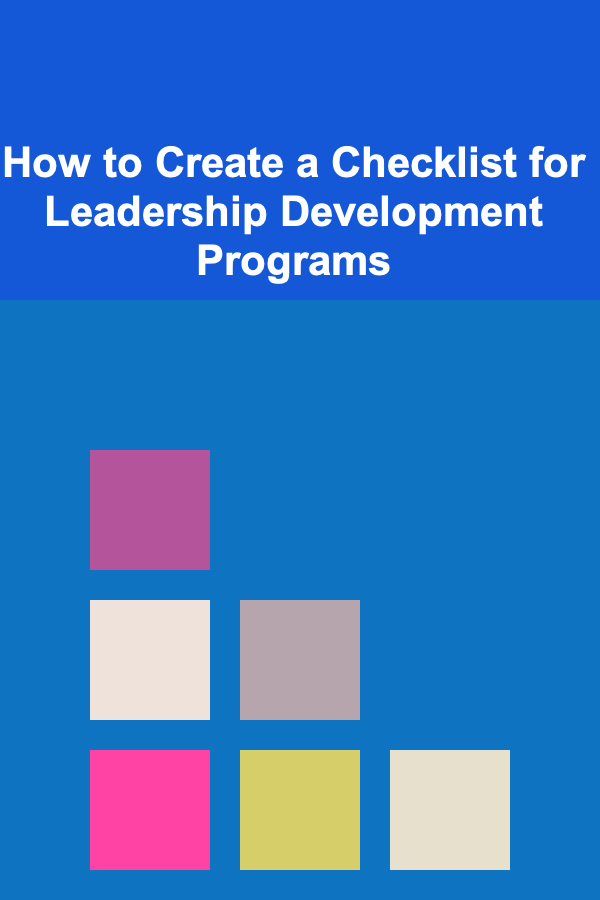
How to Create a Checklist for Leadership Development Programs
ebook include PDF & Audio bundle (Micro Guide)
$12.99$7.99
Limited Time Offer! Order within the next:

Leadership development is critical for both individual and organizational growth. Effective leaders are the backbone of any successful organization, driving innovation, inspiring teams, and delivering results. A well-structured leadership development program can nurture potential leaders, sharpen their skills, and prepare them to take on higher levels of responsibility.
Creating a checklist for a leadership development program is an essential step in ensuring its effectiveness. The checklist should serve as a roadmap, guiding participants and facilitators through the stages of growth and providing clear expectations and actions for both. Whether you're designing a new program or evaluating an existing one, a well-thought-out checklist ensures that the program is comprehensive, structured, and results-driven.
In this article, we'll delve into the steps of creating an actionable checklist for a leadership development program, broken down into key components for easy implementation.
Define Program Objectives and Outcomes
The first step in creating a checklist for a leadership development program is to define the program's objectives. What do you want participants to achieve by the end of the program? Clear objectives will set the tone for the entire process and provide direction.
Key Actions:
- Align with Organizational Goals: Understand the long-term goals of the organization. For example, if your company is focusing on expanding into new markets, you might emphasize leadership skills related to strategic decision-making, cross-cultural communication, and innovation.
- Establish Specific Outcomes: The outcomes should be measurable. For example, you could aim for outcomes like "Improved ability to manage a team of 10+ employees," or "Demonstrated proficiency in conflict resolution."
- Personal Development Goals: Apart from professional goals, focus on personal leadership traits. Participants may need to work on their emotional intelligence, adaptability, or ability to inspire others.
Example Checklist Item:
- Identify program objectives (e.g., improving strategic thinking, building communication skills).
- Link outcomes to both personal and organizational goals.
Identify the Leadership Competencies to Focus On
A leadership development program should be tailored to the competencies that are essential for effective leadership in your organization and industry. These competencies can range from interpersonal skills to strategic thinking, and they vary across different types of leaders and business contexts.
Key Actions:
-
Competency Mapping: Create a list of core leadership competencies that align with both the program's objectives and the needs of your organization. Some key competencies might include:
- Strategic Thinking: The ability to plan, predict trends, and think long-term.
- Communication: Effective communication is crucial in leadership roles, both in terms of listening and articulating ideas.
- Emotional Intelligence: Leaders need to understand and manage their emotions, as well as the emotions of others.
- Decision-Making: Leaders must be capable of making high-stakes decisions that impact the company and its employees.
- Change Management: Effective leaders help teams navigate through change.
-
Skill Level Assessment: Assess current leadership skills and identify the gap. This can be done through self-assessments, peer reviews, or 360-degree feedback.
Example Checklist Item:
- Define key leadership competencies (e.g., decision-making, change management, communication).
- Assess existing leadership competencies to identify areas of improvement.
Design a Structured Program Framework
A well-organized framework is essential for the smooth progression of the leadership development program. Structure the program in phases that cover foundational concepts and advanced leadership skills.
Key Actions:
-
Program Duration: Determine the length of the program. Leadership development can range from a few months to a year, depending on the intensity and depth of the curriculum.
-
Delivery Methods: Decide on the best delivery methods for the program. Options include:
- Workshops: In-person or virtual sessions that focus on specific leadership skills.
- Coaching: One-on-one sessions with leadership coaches to provide personalized guidance.
- Mentoring: Pairing participants with senior leaders to provide practical advice and insights.
- Group Learning: Facilitated discussions or group projects that promote collaboration and teamwork.
- Online Courses: On-demand learning modules that participants can complete at their own pace.
-
Phased Approach: A phased approach can include:
- Phase 1: Foundations of leadership (self-awareness, communication, etc.)
- Phase 2: Advanced leadership topics (strategic thinking, negotiation, etc.)
- Phase 3: Practical applications and leadership challenges (leading teams, managing crises, etc.)
Example Checklist Item:
- Design a multi-phase program (e.g., Foundations, Advanced Leadership, Practical Application).
- Select delivery methods (e.g., workshops, coaching, mentoring, online courses).
Integrate Real-World Applications
Theory is important, but leadership is developed through practice. Integrating real-world applications into the program ensures that participants have the chance to apply the skills they're learning in a meaningful way.
Key Actions:
- Leadership Challenges: Incorporate leadership challenges such as managing a project, resolving conflicts within a team, or overseeing a cross-departmental initiative. These challenges should be realistic and allow participants to practice what they're learning.
- Case Studies: Use case studies from your industry or organization to analyze leadership decisions in various situations. This helps participants to see how leadership principles apply in real-world scenarios.
- Simulations: Leadership simulations allow participants to practice skills like negotiation, decision-making, and crisis management in a safe, controlled environment.
Example Checklist Item:
- Include leadership challenges, such as managing a team or leading a project.
- Integrate case studies and simulations to reinforce learning.
Incorporate Feedback and Evaluation Mechanisms
Continuous feedback is essential for leadership growth. Participants need to know how they are progressing and where they can improve. It's equally important for the program to be evaluated to ensure its effectiveness.
Key Actions:
- Feedback Loops: Implement regular feedback mechanisms throughout the program. This could include peer feedback, mentor feedback, and self-reflection. Encourage a culture of constructive feedback where participants can receive and act on advice.
- 360-Degree Feedback: For more comprehensive evaluation, use 360-degree feedback to gather input from multiple sources (peers, managers, direct reports).
- Progress Reviews: Schedule progress reviews at the end of each phase to assess the development of leadership competencies. This can be done through one-on-one sessions with coaches or mentors.
- Program Evaluation: At the end of the program, gather feedback on its structure, delivery methods, and impact. Conduct surveys or focus groups to identify areas of improvement for future iterations of the program.
Example Checklist Item:
- Implement feedback mechanisms (e.g., peer reviews, mentor feedback).
- Conduct program evaluations at regular intervals and post-program completion.
Ensure Post-Program Support and Continuous Development
Leadership development should not end once the program is completed. Continuous growth is essential for leaders to stay relevant and effective in their roles.
Key Actions:
- Post-Program Coaching: Offer ongoing coaching or mentoring after the program ends to provide continued support. This could be on an ad-hoc basis or in the form of scheduled check-ins.
- Alumni Networks: Create a community for past participants where they can share experiences, discuss challenges, and continue learning from each other.
- Advanced Programs: Provide opportunities for advanced leadership programs for participants who want to further develop their leadership skills.
- Continuous Learning: Encourage participants to take ownership of their development by offering access to online learning resources, leadership books, and external seminars.
Example Checklist Item:
- Provide post-program coaching or mentoring.
- Set up an alumni network for continued learning and support.
Conclusion
Creating a checklist for a leadership development program is an essential step to ensure that your program is organized, comprehensive, and results-oriented. From setting clear objectives and competencies to incorporating real-world applications and continuous feedback, each step in the checklist plays a vital role in developing leaders who can drive organizational success.
By following the checklist above, organizations can foster a culture of leadership excellence and build a pipeline of leaders who are ready to take on the challenges of tomorrow. Leadership development is not a one-time event; it's an ongoing process that requires commitment, focus, and a strategic approach. With the right framework in place, both individuals and organizations will reap the rewards of a strong, capable leadership team.
Reading More From Our Other Websites
- [Metal Stamping Tip 101] Best Precision Tips for Achieving Sub‑0.005‑Inch Tolerances in CNC Metal Stamping
- [Polymer Clay Modeling Tip 101] From Rough to Refined: Smoothing and Sanding Tips for Perfect Finishes
- [Home Cleaning 101] How to Tidy Up Your Bedroom for a Calming, Organized Space
- [Home Staging 101] How to Stage Your Home for a Successful Condo Sale
- [Home Pet Care 101] Tips for Socializing Your Puppy
- [Organization Tip 101] How to Pack for Business Travel Without Stress
- [Home Soundproofing 101] How to Soundproof Your Apartment Without Hurting Your Deposit
- [Home Soundproofing 101] How to Soundproof a Cabinet and Prevent Noise Transmission
- [Personal Care Tips 101] How to Choose a Shampoo for the Perfect Daily Hair Care Routine
- [Hiking with Kids Tip 101] Designing a Kid-Centric Trail Rating System: Insights from Outdoor Experts

Effective Techniques for Negotiating for Lower Prices and Saving Big
Read More
How to Create a Themed Room That Encourages Play
Read More
How to Save Money on Landscaping and Lawn Care at Home
Read More
How to Set the Right Rent Price for Your Home Rental Property
Read More
How to Stay Connected with Colleagues Virtually
Read More
How to Produce High-Quality Written Content
Read MoreOther Products

Effective Techniques for Negotiating for Lower Prices and Saving Big
Read More
How to Create a Themed Room That Encourages Play
Read More
How to Save Money on Landscaping and Lawn Care at Home
Read More
How to Set the Right Rent Price for Your Home Rental Property
Read More
How to Stay Connected with Colleagues Virtually
Read More